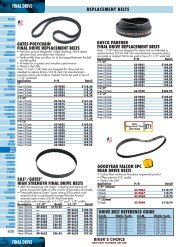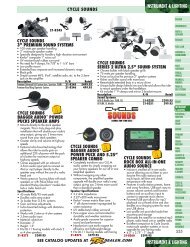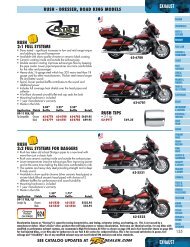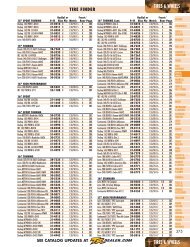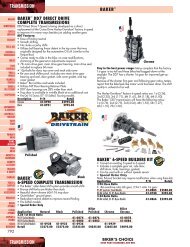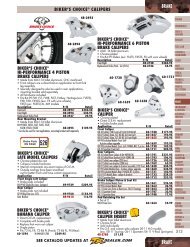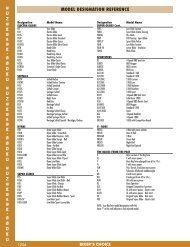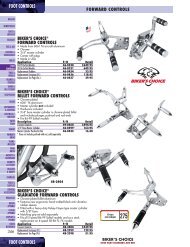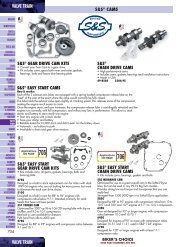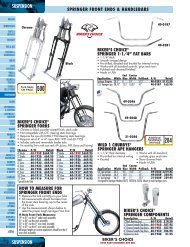Headgear - Harley-Davidson® Parts and Accessories
Headgear - Harley-Davidson® Parts and Accessories
Headgear - Harley-Davidson® Parts and Accessories
Create successful ePaper yourself
Turn your PDF publications into a flip-book with our unique Google optimized e-Paper software.
HELMET FITMENT SPECIFICATIONS<br />
HOW TO PROPERLY FIT AN ARAI ® HELMET<br />
These pages are designed only as a condensed version of your Arai ® Fit Video.<br />
They should be used as a reference only after viewing the video.<br />
THE CUSTOMER:<br />
Unless this is your customer’s very first motorcycle helmet, be prepared for them to “help” you fit them, like telling<br />
you they already know their size, etc. Politely tell them that, to you, it’s not a “helmet”, it’s an “Energy Management<br />
System”, a device whose main job is to manage the energy of an impact. In order to do its job effectively it must fit a<br />
certain way, <strong>and</strong> your job is to help determine that proper fit. This statement should change their minds <strong>and</strong> persuade<br />
them to let you do your job.<br />
HELMET FITMENT SPECIFICATIONS<br />
VISUAL EXAMINATION:<br />
Begin with a visual examination of the customer’s head shape.<br />
Head shape is as important to a proper fit as head size. Is the head round or long<br />
Does the eyebrow area protrude from the forehead, or is it level with the forehead<br />
Does the forehead protrude, is it flat, or does it slope back from the brow<br />
Is the back of the head “pointed” or flat Does the customer have a lot of hair,<br />
or little or none Are the cheeks full, or even with the facial structure, or sunken<br />
(As the Arai ® video explains, some customers – especially those who wear helmets<br />
that are too large – have full faces, <strong>and</strong> can make the mistake of wearing helmets<br />
that fit their face instead of their head.)<br />
THE MEASUREMENT:<br />
Measuring the customer’s head is the starting point for the sizing procedure.<br />
Due to varying shapes, heads that are apparently the same size when<br />
measured by a tape may not necessarily fit the same size helmet.<br />
You are trying to find the longest distance around the customer’s head, at eyebrow<br />
level, above the ears. It may require several different attempts to establish the<br />
longest possible measurement, but it is absolutely essential to getting the right fit.<br />
NOTE: Be sure to use an accurate measuring device that shows inches (in)<br />
<strong>and</strong> centimeters (cm). They are obtainable at any fabric store or order<br />
81-0128 for Arai’s measuring tape.<br />
TRYING ON THE HELMET:<br />
1<br />
First, have the customer grab the helmet by the chin straps,<br />
with the front of the helmet facing him <strong>and</strong> the top of the helmet facing down.<br />
2<br />
3<br />
He should place the thumbs on the inside surface of the straps <strong>and</strong> balance the helmet with his index fingers.<br />
Then, spreading the helmet apart by the straps, have him slip the helmet down over the head.<br />
This may take a bit of practice <strong>and</strong> extra instruction, so pay particular attention to this step.<br />
If you see that the helmet slides down on his head with little or no resistance, you have your first indication<br />
that it may be too large. Obviously, if it will not slide down over the head at all it is too small. Many people<br />
unfamiliar with proper helmet fit are reluctant to pull down if they meet resistance as the helmet goes on. Only<br />
if the helmet is impossible to put on should you move up to the next size larger, since helmets that go on snug<br />
generally fit very well once they are all the way on. Remember, most people left to their own devices will select<br />
a helmet that is too large for them. The eyes should be approximately in the center of the eye port with the top<br />
edge of the liner padding just above the eyebrows.<br />
1024



